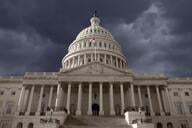You have /5 articles left.
Sign up for a free account or log in.
All through the fall semester, community colleges have been reporting enrollment growth. On Thursday, the American Association of Community Colleges released the results of a survey designed to see if the many individual reports add up to a national trend -- and the survey results suggest they do.
Nationally, head count in credit courses is up 11.4 percent over the last year, and 16.9 percent over two years, according to the survey, which included data from hundreds of colleges from every region of the country. Notably, given that about 60 percent of community college students are enrolled part time, one of the most dramatic parts of the new enrollment surge is that it is coming in large part by full-time students. Over the last two years, the percentage gain in full-time students has been more than twice the rate as for part-time students.
Changes in Enrollment Head Count at Community Colleges
| Full Time | Part Time | Total | |
| 2007 to 2008 | 6.6% | 3.9% | 4.9% |
| 2008 to 2009 | 16.4% | 7.1% | 11.4% |
| 2007 to 2009 | 24.1% | 11.4% | 16.9% |
In terms of geography, the rates of increase were largely similar across urban, suburban and rural community colleges. But by region, there were clear differences, with the Rocky Mountains seeing the largest increases and being the only region where part-time enrollments outpaced full-time enrollments.
Enrollment Changes at Community Colleges, 2007-9
| New England | Mid East | Great Lakes | Plains | Southeast | Southwest | Rocky Mountains | Far West | |
| Full Time | 19.6% | 18.4% | 23.3% | 18.2% | 27.9% | 22.1% | 31.2% | 31.4% |
| Part Time | 12.2% | 9.7% | 9.2% | 13.8% | 11.7% | 17.8% | 39.1% | 4.2% |
| Total | 15.1% | 13.8% | 14.3% | 15.9% | 18.7% | 19.2% | 36.0% | 17.2% |
A report on the results, by Christopher M. Mullin, the AACC program director for policy analysis, and Kent Phillippe, director of research, says that despite the increases, many community colleges fear that they lost students who should have enrolled. And the report notes that many community colleges that were not operating at capacity prior to the enrollment boom may be doing so now.
"The reality of enrollment management is that one never knows how many students who wished to enroll were unable to do so," the report says. Given the importance community colleges place on being "open door institutions," the survey asked whether colleges believed that some potential students were turned away from programs due to capacity issues, and 34.2 percent answered in the affirmative. Asked why students didn't enroll, colleges cited students not having enough money, or flexibility to take courses when they are offered.
Capacity issues were most severe, colleges reported, in programs (such as nursing) with laboratory and other equipment needs.
The experience this fall, the report says, suggests some national policy issues that need attention. One is the need to better educate potential students about financial aid. The report notes that many students who are eligible for aid showed up to enroll without having applied. The other issue is about transfer. With so many more students enrolling at community colleges, the report notes, pressure will grow on four-year institutions when more of these students than in the past want to finish bachelor's programs elsewhere.
Karen Bleeker, president of the Community College of Denver, which is up more than 35 percent in enrollment this fall, said that the national data didn't surprise her. Bleeker said that whether the program is accounting or early childhood education or general education or remedial education, the number of sections is way up, and administrative spaces are being cleared to make more room for classrooms.
One of her deans joked, Bleeker said, that the next person added to one office would have to be attached with Velcro to the ceiling. So far, it looks like the spring enrollments may be up by as much as 50 percent, Bleeker added.
Based on a belief that the college has to respond to students who want to enroll right now, Bleeker said that she does not want anyone turning away students. In the past, the college has sometimes limited sections. With this enrollment surge, she said, "I've told people to just keep filling your sections and then we'll open more sections and we promise we'll find space somewhere."
Deborah M. DiCroce, president of Tidewater Community College, in Virginia, said her institution is fortunate to have recently opened several new facilities, so it is able to handle the larger-than-projected enrollment increase. This fall, when the college expected to see student numbers grow by 6.5 percent, the actual increase was 17.8 percent.
In a split similar to the national data reported by the AACC, Tidewater has seen full-time enrollment grow by 26.4 percent, while part-time enrollment is up only 7.4 percent. DiCroce said that she believes that the economic downturn is the key explanation, with more people feeling the need to either prepare for new jobs or to start higher education without spending as much as they would at a residential four-year institution.
In a shift that she believes is also related to the economy, Tidewater is seeing male enrollment increases outpace female increases (17.4 percent vs. 11.3 percent) for the first time in many years.
Some community colleges started midnight courses this semester as a way to make full use of classroom facilities and to enroll students who have full non-academic lives. Tidewater hasn't gone that route, but DiCroce said that more courses than ever before are being offered at 7 a.m. (in person) and online. "Everything is up," she said.




